With their flexible nature, online learning platforms allow students to learn at their own pace. Also, these courses are much cheaper when you compare them to university and college fees. Besides learners, these courses benefit educators by allowing them to share their knowledge with a global audience. Read this article to learn about the best online learning platforms to gain knowledge and skills.
Top 10 Online Platforms for Learning
After acknowledging the importance of e-learning online platforms, you may want to know about the best options available. Worry not because we have identified the top online platforms that can help you gain knowledge and acquire new skills. So, go through these top online learning platforms for students and professionals to start your journey.
1. Udemy
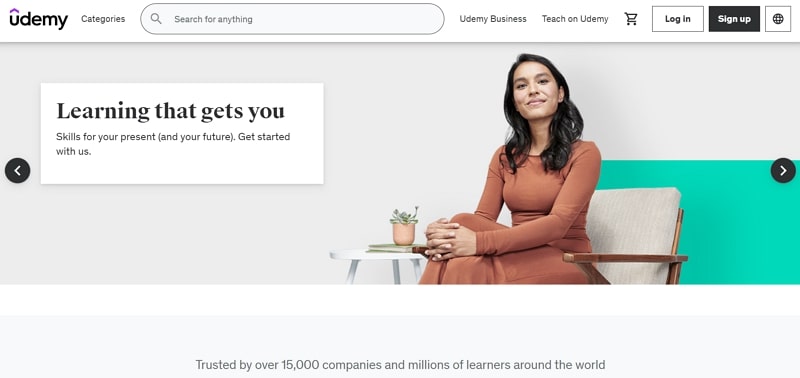
Students and teachers can take advantage of this online platform for learning and knowledge sharing. On this platform, you can also subscribe to the Udemy Business plan to train your workforce with over twenty thousand courses for working professionals. Other than that, it has over 62 million students in 180+ countries, making it a perfect platform for teachers to reach learners globally. Plus, students can find courses belonging to different categories to boost their knowledge.
Pros:
- Wide variety of courses across numerous subjects.
- Affordable pricing with frequent discounts.
- Lifetime access to purchased courses.
- Courses created by industry experts.
Cons:
- Course quality can vary widely.
- Limited interaction with instructors.
- No formal accreditation or degrees.
| Metrics | Udemy |
|---|---|
| Number of Courses | Around 210,000 |
| Top Categories | Design, Development, Marketing, IT and Software, Business |
| Pricing Range | Approximately $10.00 to $199.99 |
| Ratings | 4.5 on G2 with 595 Reviews |
2. Coursera
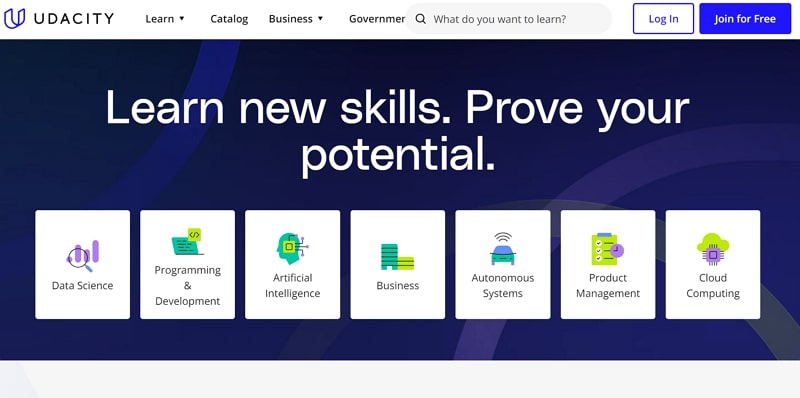
With several free courses available, Coursera has become a top online learning website for students of every kind. Moreover, it gives you the option to save over 100 dollars on paid courses during your first year of learning. This advanced learning platform even allows you to get online master’s and bachelor’s degrees without physically going to college. Plus, the certification offered by this platform proves to be valuable in professional settings.
Pros:
- Courses from top universities and institutions.
- Offers degrees and professional certificates.
- High-quality, well-structured content.
- Financial aid available for many courses.
Cons:
- Some courses can be expensive.
- Not all content is self-paced; some have set schedules.
- Limited access to course materials without a subscription.
| Metrics | Coursera |
|---|---|
| Number of Courses | Over 7000 |
| Top Categories | Data Analysis, IT, Business, Computer Science |
| Pricing Range | Guided Projects: Starts from $9.99, Professional Certifications: Starts from $39.99, Degree Programs: Starts from $9000 |
| Ratings | 4.5 on G2 with 348 Reviews |
3. edX

edX collaborates with over 260 international institutions to provide students with access to global knowledge. It is an award-winning online education platform recognized for its contribution to career development. Using its enterprise solutions, businesses can also upskill their employees with extensive training solutions. In addition to that, this platform provides students with online quizzes and assessments to help them learn better.
Pros:
- Courses from renowned universities like Harvard and MIT.
- Offers micro-masters and professional certificates.
- High-quality, academically rigorous content.
- Many courses are free to audit.
Cons:
- Certificates and full access require payment.
- Some programs can be quite costly.
- Limited interaction with peers and instructors.
| Metrics | edX |
|---|---|
| Number of Courses | 4000+ |
| Top Categories | Artificial Intelligence, Data Science, Finance, Cybersecurity |
| Pricing Range | Within $50 to $300 |
| Ratings | 4.5 on G2 with 110 Reviews |
4. Khan Academy
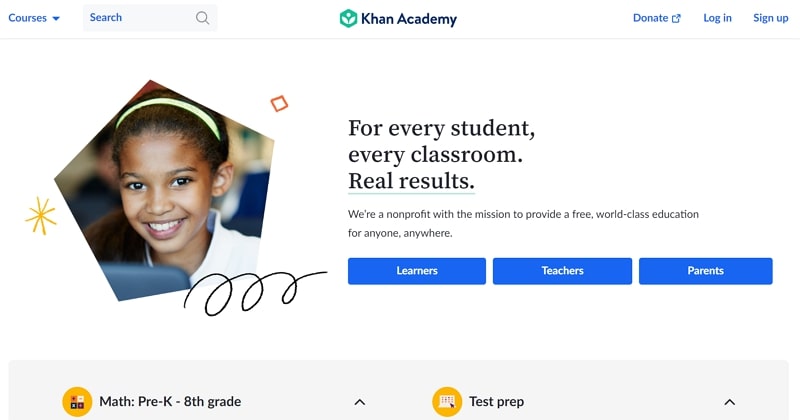
Khan Academy is an innovative learning platform that targets young students to help them take initial steps towards success. Within this best online education platform, you will find courses for early graders, from 2nd to 8th grade. Also, students preparing for college tests can benefit from the MCAT, LSAT, and other relevant courses. This platform also allows teachers to identify gaps in students’ learning and push them toward professional victory.
Pros:
- Completely free and accessible to everyone.
- Great for foundational learning and school subjects.
- Easy-to-follow, high-quality content with practice exercises.
- Ad-free and nonprofit.
Cons:
- Limited in advanced or professional-level courses.
- Primarily focused on K-12 and early college education.
- No certification for courses completed.
| Metrics | Khan Academy |
|---|---|
| Number of Courses | Over 20 Courses per Category |
| Top Categories | Test Preparation, Computing, Science |
| Pricing Range | Free of Cost |
| Ratings | 4.5 on G2 with 179 Reviews |
5. LinkedIn Learning
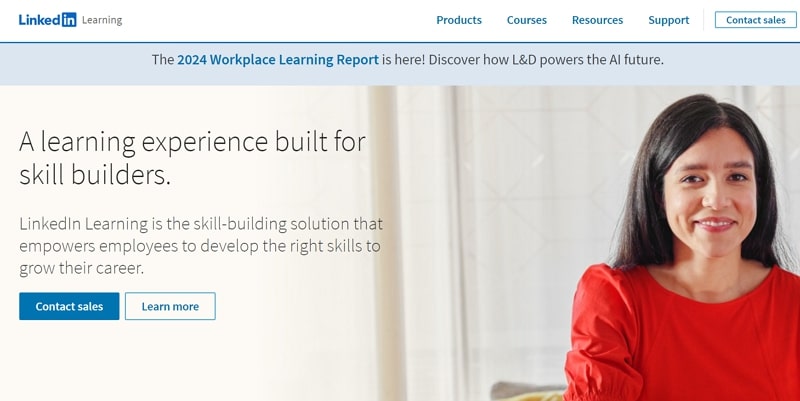
Using this job-hunting platform, professionals can even hone their skills to get better opportunities. You will be able to learn from industry experts about all the secrets to be successful in the relevant field. Also, this platform for online learning lets you get professional knowledge free of cost for the starting month. Other than that, you can benefit from project files and online quizzes to get practical experience.
Pros:
- Integration with LinkedIn profile to showcase completed courses.
- Wide range of professional and skills-based courses.
- Offers a free trial and monthly subscription model.
- High-quality content with industry experts.
Cons:
- No formal accreditation or degrees.
- Subscription can be pricey if not used regularly.
- Courses are generally shorter and less in-depth.
| Metrics | LinkedIn Learning |
|---|---|
| Number of Courses | 20000+ |
| Top Categories | Adobe Software, Electronics, HTML, Data Analysis, Excel |
| Pricing Range | Personal: Starts from $19.99 per month, Teams: $379.88 per year per seat |
| Ratings | 4.4 on G2 with 654 Reviews |
6. OpenLearning
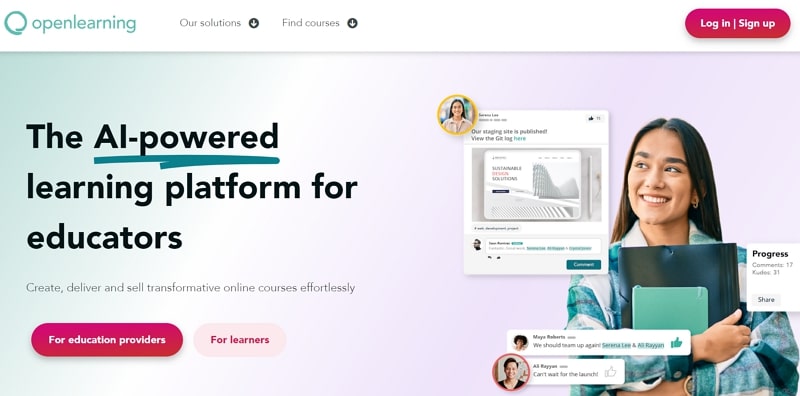
OpenLearning is an AI-integrated online learning platform that allows users from worldwide to acquire knowledge and skills. With this platform, you can also create your courses with elements like activity-based learning. Learners will be able to find short courses on this online learning site to explore new subjects quickly. In addition, you can acquire new skills practically through its innovative OpenCreds framework.
Pros:
- Focuses on community-driven and social learning.
- Offers flexibility in course creation for educators.
- Affordable courses and customizable learning paths.
- Engages learners through active participation.
Cons:
- Course quality varies depending on the instructor.
- Limited recognition or formal accreditation.
- Smaller course catalog compared to larger platforms.
| Metrics | OpenLearning |
|---|---|
| Number of Courses | 300+ Public 4250+ Private |
| Top Categories | Arts and Design, Education, Health and Medicine, Engineering |
| Pricing Range | Starter: $1170 per year for 2 Educators and 100, Learners Institution Plan: $4485 per year for 10 Educators and 500 Learners |
| Ratings | 4.6 on G2 with 5 Reviews |
7. Udacity
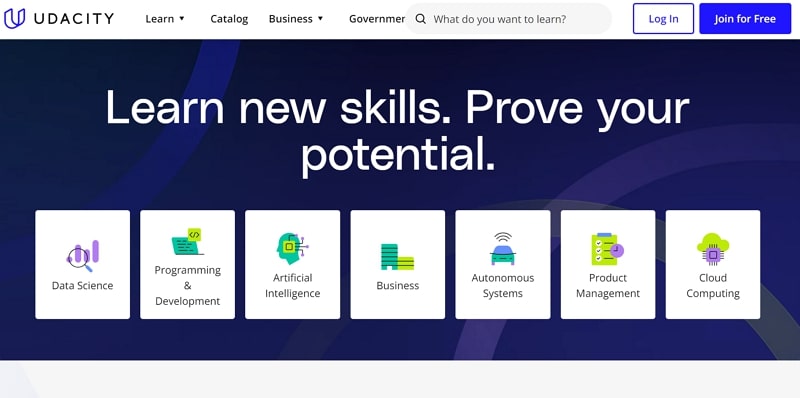
Young professionals can utilize this e-learning online platform to develop new skills and prove their worth in work settings. While learning on this platform, you get to demonstrate your skills on their open-ended projects. After completing the project, you will receive personalized feedback from industry experts. Also, there are mentors available on this learning website who will guide you through your mistakes.
Pros:
- Focuses on tech and job-ready skills, especially in AI, data science, and programming.
- Offers nano-degrees with a structured learning path.
- Strong industry partnerships provide relevant, up-to-date content.
- Career support and mentorship included.
Cons:
- High cost for nano-degrees.
- Limited course variety outside of tech-related fields.
- Intensive time commitment for some programs.
| Metrics | Udacity |
|---|---|
| Number of Courses | 350+ Courses370+ Real-World projects |
| Top Categories | Cloud Computing, Programming, Data Engineering, Autonomous Systems |
| Pricing Range | Month-to-Month: $249, 4 Months: $846 |
| Ratings | 4.5 on G2 with 736 Reviews |
8. MasterClass

MasterClass is pretty different from other online platforms, as it has short-in-length video lectures. You can get access to courses that fit your needs by filling out a personalized survey when you first visit this online learning platform for students. The development team does its best to add new courses every month to provide new learning opportunities to students. In addition, students can watch the Skill Builder series introduced by this platform to hone their skills through entertainment.
Pros:
- Courses taught by celebrities and top professionals.
- High production quality and engaging content.
- Focuses on creative and lifestyle skills.
- Annual subscription allows access to all classes.
Cons:
- Not academically rigorous; more inspirational than instructional.
- No certifications or formal qualifications.
- Less practical application and more theory.
| Metrics | MasterClass |
|---|---|
| Number of Courses | Over 200 Courses across 11 Categories |
| Top Categories | Acting and Performing Arts, Digital Content, Music, Design and Creative Arts |
| Pricing Range | Standard: $6 per month Plus: $15 per month, Premium: $20 per month |
| Ratings | 4.3 on G2 with 13 Reviews |
9. SkillShare
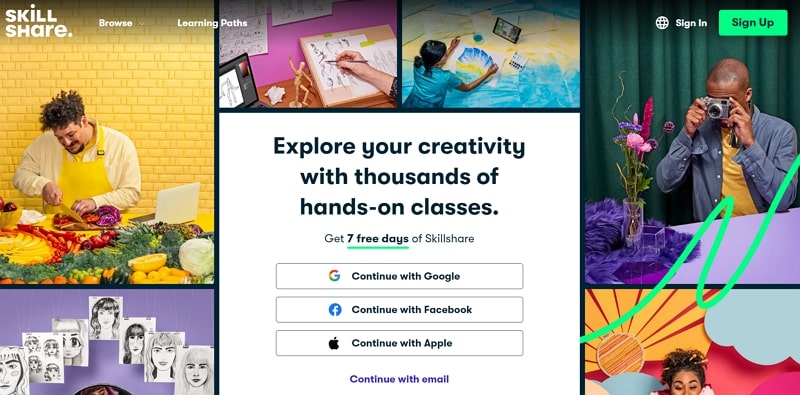
Students wanting to learn creative skills to add flavor to their lives can benefit from SkillShare. With this online education platform, you can connect with thousands of creative artists, including YouTubers, Illustrators, and Graphic Designers. Plus, this platform is very different from conventional learning sites that only focus on professional learning topics. Also, there is a team plan available for businesses to train their employees for a creativity boost.
Pros:
- Emphasizes creative skills and hands-on projects.
- Affordable subscription with access to all classes.
- Engages users through community projects and peer feedback.
- Wide range of topics, especially in creative arts.
Cons:
- No formal accreditation or certificates.
- Quality varies significantly between courses.
- Subscription model might not suit those only interested in a few classes.
| Metrics | SkillShare |
|---|---|
| Number of Courses | 35000+ Classes |
| Top Categories | Animation, Creative Writing, UI/UX Design, Music, Graphic Design |
| Pricing Range | Premium: $168 per year |
| Ratings | 4.8 on the Apple App Store |
10. FutureLearn
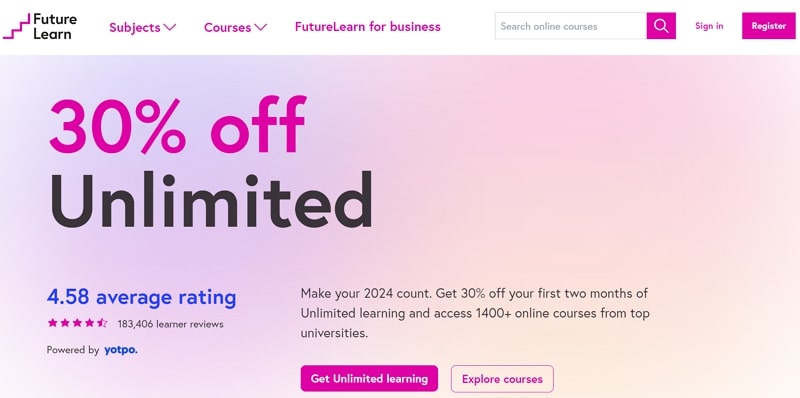
FutureLearn is an all-in-one online learning website for students and professionals with courses from every industry. It is affiliated with over 200 hundred world-class universities and teachers to deliver the best learning experience to students globally. Plus, students can get access to online undergraduate and postgraduate degrees to get professional education from their homes. Additionally, you will be able to gain insights into any desired field through its short courses.
Pros:
- Courses from top universities and organizations.
- Offers micro-credentials, short courses, and degrees.
- Free to access content with the option to pay for certificates.
- Strong emphasis on social learning and interaction.
Cons:
- Certificate and full access require payment.
- Course selection can be limited in certain fields.
- Not all courses offer in-depth content.
| Metrics | FutureLearn |
|---|---|
| Number of Courses | Over 1400 |
| Top Categories | Healthcare and Medicine, Teaching, IT, Business Management |
| Pricing Range | Monthly Plan: $39.99 per month, Yearly Plan: $29.17 per month |
| Ratings | 4.4 on G2 with 19 Reviews |
What Value Do Online Learning Platforms Bring?
Online learning platforms bring significant value by offering flexibility and convenience, allowing learners to access courses anytime and anywhere. They eliminate geographical barriers, making quality education accessible to a global audience. These platforms often provide a wide range of resources, including videos, quizzes, and interactive tools, catering to different learning styles.
Additionally, online learning is typically more cost-effective than traditional education, reducing expenses related to travel, accommodation, and physical materials. Many platforms also support self-paced learning, enabling individuals to progress according to their own schedules and commitments. Furthermore, features such as discussion forums, live sessions, and real-time feedback foster engagement and collaboration, creating a supportive learning environment.
How to Choose the Best Online Learning Platform?
To choose the best online learning platform, consider the following key factors:
- Course Variety and Quality: Look for platforms that offer a wide range of courses in your area of interest with content from reputable institutions or expert instructors.
- Learning Format and Flexibility: Check if the platform provides various formats like videos, readings, quizzes, and interactive exercises. Ensure the platform allows you to learn at your own pace or has schedules that fit your availability.
- Accreditation and Certification: Verify whether the platform offers accredited courses or recognized certifications that can add value to your resume or career prospects.
- User Experience and Accessibility: Choose a platform with a user-friendly interface, good customer support, and accessibility on different devices, such as mobile phones, tablets, and computers.
- Pricing and Subscription Models: Compare pricing plans and subscription options. Look for platforms that offer good value for money, including free trials or financial aid if needed.
- Community and Support: A strong community or access to forums, mentors, or peer support can greatly enhance your learning experience by providing additional guidance and motivation.
Difference between Online Learning Platforms and Learning Management Systems
Online learning platforms and learning management systems (LMS) serve distinct purposes in the realm of education and training, though they may sometimes overlap in functionality.
| Feature | Online Learning Platforms | Learning Management Systems (LMS) |
|---|---|---|
| Purpose | Deliver educational content to individual learners. | Manage, deliver, and track educational programs for organizations. |
| Examples | Coursera, Udemy, Khan Academy | Moodle, Blackboard, Canvas |
| Content Creation | Courses created by various instructors or third parties. | Designed for instructors to create and manage their own courses. |
| Target Audience | Individual learners seeking specific skills or knowledge. | Educational institutions, businesses, and training programs. |
| Flexibility | Offers self-paced, on-demand learning. | Can be structured with set schedules and deadlines. |
| User Management | Focuses on individual learners with minimal user management. | Includes user management features like enrollment, roles, and permissions. |
| Assessment and Tracking | Basic assessments like quizzes; limited tracking. | Robust tracking, detailed analytics, and assessment tools. |
| Certification | Often provides certificates upon course completion. | Can issue certifications, diplomas, and detailed reports. |
| Community Features | May include forums or social learning elements. | Strong community and collaboration tools (forums, messaging). |
| Integration | Limited integration with other systems. | Integrates with various tools like HR systems, email, and content libraries. |
| Pricing Model | Subscription-based, pay-per-course, or free access. | Often subscription-based or one-time licensing fees. |
Effective Ways to Monetize Your Content on Online Learning Platforms
To monetize your content on online learning platforms, start by choosing the right platform that aligns with your goals, such as Udemy, Teachable, or Skillshare, keeping in mind their fee structures and revenue shares. Create high-quality, engaging content in a niche you are knowledgeable about and that has market demand. Focus on producing comprehensive courses with clear, well-organized material, and invest in good production quality to make your content stand out.
Pricing your course competitively is crucial—research similar courses to find a price point that balances value and accessibility. Additionally, take advantage of the platform’s promotional tools and offer discounts or bundle deals to attract more students. Actively market your course through social media, blogs, email newsletters, and other channels to drive traffic. Engage with your students by responding to feedback and updating your content regularly, which helps maintain course relevance and encourages positive reviews, boosting your visibility and sales.
Finally, explore multiple income streams by offering additional services such as one-on-one coaching, exclusive webinars, or downloadable resources, which can further enhance your earnings from your online courses.
How to Create Online Education Platforms Like Udemy?
Now, you know about the top online platforms for learning that are accessible to every student globally. If you are inspired by these platforms, you can create them using a simple strategy. For this purpose, you have to follow the step-by-step method explained below.
1. Research About the Niche of Courses
Educators excited about delivering lectures worldwide should first select the niche of courses they want to upload on their learning platform. So, they have to identify their area of expertise and research if they can find enough teachers related to this niche.
Also, you need to determine the demand of the online courses you are thinking of providing to the online students. All these factors will help you choose the perfect niche of courses for your online learning platform.
2. Select a Business Model for Your Online Platform for Learning
Once you are satisfied with your niche, you need to choose a business model to earn revenue from online courses. Educators can go for the paid certificate model if they want their students to access courses for free.
In addition, they can go for a subscription-based model to give students access to all courses at a certain price. However, starting with a paid courses model is recommended to let students only pay for the courses they want.
3. Determine All the Features of Your Learning Platform
Before starting the development process, you should also outline all the features you want to add to your online education platform. For this purpose, you need to decide what courses to insert in your most recommended section.
Also, you have to choose the type of content and UI/UX elements to be added to the courses. Finally, educators can select the payment methods and dashboard features they want to add to their site.
4. Start the Development Process and Integrate ZEGOCLOUD APIs
Upon completing the planning process, it is time to turn your ideas into practical e-learning online platforms. For this purpose, you can either start from scratch or utilize custom-made APIs to integrate several features into your website. If you are new to development, we recommend you use ZEGOCLOUD APIs to boost the functionality of your learning platform. With its video-calling SDKs, educators can add a 1-on-1 tutoring feature to their learning application.
Moreover, you get to integrate live-streaming APIs into your online learning website for teaching a large group of students. Using this API/SDK provider, you will be able to deliver real-time learning experiences to students with ultra-low latency rates. After integrating these APIs, you can work with other developers to improve the user interface of your website and deliver the best courses to your students.
5. Collaborate with Professional Educators
After creating an online platform for learning, you need to reach out to quality educators to get more study material on your website. The content of the courses matters the most, so you really have to focus on this area of the education platform creation process.
Our Development Experience of E-learning Online Platform
Recently, we helped TAL, our client from China, integrate live streaming and 1-on-1 interactive classes into their online learning platform. TAL is an educational group that works towards improving the educational system by providing innovative solutions. However, they were facing a challenge in integrating live streaming big classes and small interactive classes into their educational system. So, ZEGOCLOUD comes to the rescue with its multi-functional APIs and SDKs.
To solve their problems, we integrated our video and audio calling APIs into their educational system to help them implement a small class model. Also, with our ultra-low latency live streaming APIs, ZEGOCLOUD helped them carry out real-time live stream classes to reach students worldwide.
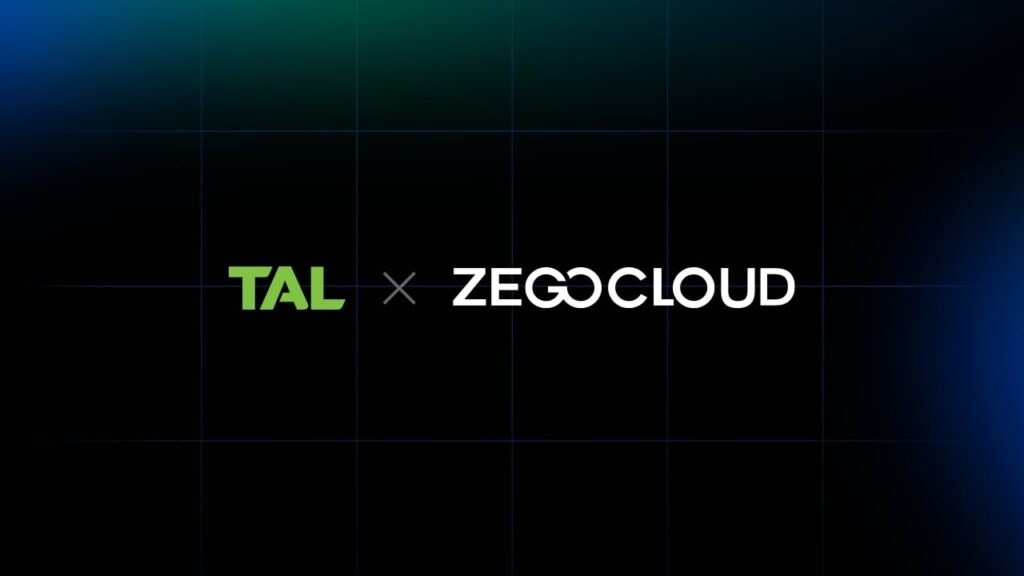
Conclusion
Throughout this article, we have learned about different online learning platforms to help gain knowledge and skills. Students and professionals can utilize any of these best online education platforms to excel in their careers. Moreover, we have introduced educators who are willing to create their learning platform with an advanced API/SDK provider. With ZEGOCLOUD APIs, you can deliver real-time lectures to students with video and live-streaming features.
Read more:
FAQ
Q1: What is the best online learning platform?
The best platform depends on your goals. Coursera and edX are great for academic and professional courses, Udemy for practical skills, Skillshare for creative fields, and Khan Academy for foundational education.
Q2: What is the meaning of online learning platforms?
Online learning platforms are tools that deliver education via the internet, providing course materials, interactive features, and remote learning opportunities for various subjects.
Q3: How effective are online learning platforms?
They are effective when well-designed, offering quality content, flexibility, and interactivity. Success depends on the platform’s resources and the learner’s motivation and discipline.
Q4: What is the best eLearning website?
Coursera and edX are best for academic learning, Udemy for skills, Skillshare for creative courses, and Khan Academy for foundational topics. Choose based on your needs.
Let’s Build APP Together
Start building with real-time video, voice & chat SDK for apps today!










